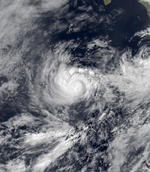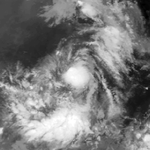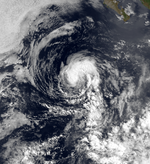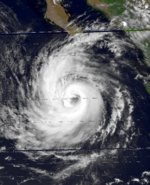| 1980 Pacific hurricane season | |
|---|---|
 Season summary map Season summary map | |
| Seasonal boundaries | |
| First system formed | April 4, 1980 |
| Last system dissipated | October 29, 1980 |
| Strongest storm | |
| Name | Kay |
| • Maximum winds | 140 mph (220 km/h) (1-minute sustained) |
| Seasonal statistics | |
| Total depressions | 16 |
| Total storms | 15 |
| Hurricanes | 7 |
| Major hurricanes (Cat. 3+) | 3 |
| Total fatalities | 0 |
| Total damage | Unknown |
| Related articles | |
| Pacific hurricane seasons 1978, 1979, 1980, 1981, 1982 | |
The 1980 Pacific hurricane season officially started May 15, 1980, in the eastern Pacific and June 1, 1980, in the central Pacific, lasting until November 30, 1980. These dates conventionally delimit each year when most tropical cyclones form in the northeastern and central Pacific Ocean. This season was relatively uneventful; since no tropical cyclones made landfall, there were no reports of casualties or damage.
Overall, the 1980 season was slightly below the long-term average, with 16 tropical cyclones forming. Of those, 15 were named, 7 reached hurricane intensity, and only 3 became major hurricanes by attaining category 3 status or higher on the Saffir–Simpson scale. All eastern Pacific systems this year formed in the eastern Pacific proper and two storms crossed into the central Pacific: Carmen from the west and Kay from the east. The season had an early start when Carmen crossed over the International Date Line in April. The strongest storm of this season is Hurricane Kay, peaking at 140 mph (225 km/h). Kay lasted for fourteen and a half days, which was the fifth-longest-lasting Pacific hurricane at the time.
Season summary

The 1980 Pacific hurricane season began on April 5, 1980, with the crossing of the International Date Line by Tropical Storm Carmen and ended with the dissipation of Tropical Depression Newton on October 29. Of the sixteen tropical cyclones that in the eastern north Pacific Ocean during 1980, one was a tropical depression, eight were tropical storms, and seven were hurricanes, of which three were major hurricanes of Category or higher on the Saffir–Simpson scale. Of these systems, all except one tropical storm formed east of 140°W in the eastern Pacific proper. These totals are below the long-term average of fifteen tropical storms, nine hurricanes, and four major hurricanes. Two tropical cyclones existed in the central Pacific, both of which crossed in from other tropical cyclone basins. This total is below the average of four or five tropical cyclones per year.
Systems
Hurricane Agatha
| Category 3 hurricane (SSHWS) | |
  | |
| Duration | June 9 – June 15 |
|---|---|
| Peak intensity | 115 mph (185 km/h) (1-min); |
Agatha originated from a tropical depression that formed 400 mi (640 km) south-southwest of Acapulco on June 9. After becoming better organized, EPHC upgraded the depression into a tropical storm later that day, giving it the name Agatha. The storm turned north then northwest and strengthened into a hurricane. On June 12, Agatha reached its peak intensity with maximum sustained winds of 115 mph (185 km/h), a category 3 hurricane on the Saffir–Simpson hurricane wind scale. After entering an area with cooler sea surface temperature and stable air, Agatha steadily weakened into a tropical storm on June 13 and a tropical depression on June 14. The EPHC issued the last advisory on Agatha on the following day as Agatha rapidly dissipated.
Tropical Storm Blas
| Tropical storm (SSHWS) | |
  | |
| Duration | June 16 – June 19 |
|---|---|
| Peak intensity | 60 mph (95 km/h) (1-min); |
A disturbance south-southwest of Acapulco developed a circulation and was designated Tropical Storm Blas on June 16. It headed northwest, and intensified, peaking in windspeed that same day. The cyclone then steadily weakened and dissipated on June 19, twelve hours after weakening into a tropical depression.
Tropical Depression Three
| Tropical depression (SSHWS) | |
 | |
| Duration | June 17 – June 19 |
|---|---|
| Peak intensity | 35 mph (55 km/h) (1-min); |
A disturbance south of Acapulco developed into a tropical depression on June 17. It moved northwest and then west, and never strengthened much. The tropical cyclone dissipated on June 19 after moving over cooler waters.
Hurricane Celia
| Category 1 hurricane (SSHWS) | |
  | |
| Duration | June 25 – June 29 |
|---|---|
| Peak intensity | 75 mph (120 km/h) (1-min); |
A tropical disturbance moving west-northwestward organized into a tropical depression on June 25. It quickly strengthened to Tropical Storm Celia. Celia intensified into a hurricane on June 26 and reached its peak intensity from June 26 to June 28. Celia then curved to the northwest as it wheeled around the edge of a ridge. Celia weakened into a tropical storm on June 28, a depression on June 29, and dissipated just after that. It remnants remained, and cloudiness and moisture associated with the cyclone were carried into the Continental United States by an upper-level trough.
Celia's remnants and moisture brought rain to Santa Barbara County, California, on the last two days of June. Other than that, Celia caused no impact.
Tropical Storm Darby
| Tropical storm (SSHWS) | |
  | |
| Duration | July 1 – July 3 |
|---|---|
| Peak intensity | 50 mph (85 km/h) (1-min); |
On July 1, a westward-moving tropical disturbance located to the southwest of Acapulco organized into a tropical depression. The next day, it intensified into a tropical storm as it briefly jogged to the north. Darby peaked in wind speed just after that. It then weakened into a depression on July 3 and dissipated later that day.
Tropical Storm Estelle
| Tropical storm (SSHWS) | |
  | |
| Duration | July 12 – July 13 |
|---|---|
| Peak intensity | 45 mph (75 km/h) (1-min); |
An area of disturbed weather developed gale-force winds and a cyclonic circulation and was upgraded directly to tropical storm status on July 12. Estelle's winds peaked in velocity just after that. The cyclone then steadily weakened as it curved to the west-northwest. Estelle dissipated on July 13. Estelle did not affect land. No damage or casualties were attributed to this tropical cyclone.
Tropical Storm Frank
| Tropical storm (SSHWS) | |
  | |
| Duration | July 18 – July 22 |
|---|---|
| Peak intensity | 50 mph (85 km/h) (1-min); |
A tropical disturbance northeast of Clipperton organized into a tropical depression on July 18. Heading northwestwards, it intensified into a tropical storm on July 20. Frank reached its maximum wind speed shortly after that. The cyclone then turned to the west and gradually weakened, dissipating on July 22.
Hurricane Georgette
| Category 1 hurricane (SSHWS) | |
  | |
| Duration | July 28 – July 31 |
|---|---|
| Peak intensity | 75 mph (120 km/h) (1-min); |
A tropical disturbance formed southwest of Acapulco on July 26. The disturbance was then upgraded to a tropical depression on July 28. The cyclone headed northwest. It intensified into a tropical storm on July 29. That same day, Georgette was briefly a hurricane. The cyclone turned to the west and weakened, dissipating on July 31.
Hurricane Howard
| Category 2 hurricane (SSHWS) | |
  | |
| Duration | July 31 – August 7 |
|---|---|
| Peak intensity | 105 mph (165 km/h) (1-min); |
A tropical disturbance south of Acapulco developed into a tropical depression on July 31. It headed west, and then gradually curved to the northwest as it paralleled the coast of Mexico. The cyclone became a storm shortly after forming, a hurricane on August 2, and peaked in windspeed on August 4. It then steadily weakened after that, and dissipated over cool waters shortly after becoming a tropical depression on August 7. Howard threatened the coasts of Southern California and the northern part of the Baja California Peninsula, but in the end, never approached land.
Hurricane Isis
| Category 2 hurricane (SSHWS) | |
  | |
| Duration | August 5 – August 11 |
|---|---|
| Peak intensity | 100 mph (155 km/h) (1-min); |
A tropical disturbance south of Acapulco developed into a tropical depression on August 5 and a tropical storm the next day. Isis headed generally west-northwest and peaked as a Category 2 hurricane on August 8. Isis then weakened, becoming a tropical storm on August 10, turning to the west, and dissipating the next day.
Hurricane Javier
| Category 3 hurricane (SSHWS) | |
  | |
| Duration | August 22 – August 29 |
|---|---|
| Peak intensity | 115 mph (185 km/h) (1-min); |
An area of disturbed weather south of the Gulf of Tehuantepec became a tropical depression on August 22 and a storm the next day. Javier became a hurricane on August 24 and peaked as a major hurricane on August 25. Javier then weakened, becoming a tropical storm on August 27 and a storm the next day. It dissipated on August 29, having moved west-northwest for almost its entire life.
Hurricane Kay
| Category 4 hurricane (SSHWS) | |
  | |
| Duration | September 16 – September 30 |
|---|---|
| Peak intensity | 140 mph (220 km/h) (1-min); |
A tropical disturbance south of Acapulco developed into a tropical depression on September 16 and a tropical storm later that day. Kay headed in an irregular but generally west-northwest path out to sea. Kay strengthened into a hurricane on September 17. It continued strengthening and reached its peak as a Category 4 hurricane on the Saffir–Simpson scale on September 18. Kay then slowly weakened and was a tropical storm by September 20. Kay's forward motion slowed as it neared the central Pacific. It restrengthened into a hurricane on September 23, crossed 140°W, and entered the Central Pacific Hurricane Center's area of responsibility the next day. Kay executed a small anticyclonic loop, and then began weakening again. It became a tropical storm again on September 27, and a depression two days later. The cyclone dissipated on September 30 while located north of the Hawaiian Islands. Kay did not effect land, causing no damage or casualties. It was the strongest tropical cyclone of the season at 140 mph (225 km/h). Kay lasted for 14.5 days, enough to make it the fifth-longest-lasting Pacific hurricane at the time.
Tropical Storm Lester
| Tropical storm (SSHWS) | |
  | |
| Duration | September 21 – September 25 |
|---|---|
| Peak intensity | 40 mph (65 km/h) (1-min); |
A westward-moving disturbance south of Acapulco strengthened into a tropical depression on September 21. Continuing on its path, it intensified into Tropical Storm Lester on September 23. Lester's motion then slowed down, and it spun about in the open ocean until it dissipated on September 25.
Tropical Storm Madeline
| Tropical storm (SSHWS) | |
  | |
| Duration | October 11 – October 12 |
|---|---|
| Peak intensity | 50 mph (85 km/h) (1-min); |
A disturbance east of Clipperton became a tropical depression and then a tropical storm. It headed northwest and weakened into a depression on October 12. It dissipated shortly afterward.
Tropical Storm Newton
| Tropical storm (SSHWS) | |
  | |
| Duration | October 28 – October 29 |
|---|---|
| Peak intensity | 40 mph (65 km/h) (1-min); |
An area of disturbed weather southeast of Socorro Island became a tropical storm on October 28. It headed northeast and approached the coast of Mexico. However, an area of high wind shear and cool waters destroyed the cyclone on October 29, before it could reach the coast. Newton was the tropical cyclone that came closest to making landfall this season. However, no impact was reported.
Other system
See also: List of off-season Pacific hurricanesOn April 4, a tropical depression formed just east of the International Date Line. The Joint Typhoon Warning Center (JTWC) designated it Tropical Depression 02W. As it moved generally northwestwards, the depression, strengthened into a tropical storm just before crossing the Date Line, at which time JTWC named the storm Carmen. After peaking with maximum sustained winds of 70 mph (110 km/h) on April 6. Carmen recurved northeast and crossed the Date Line again, entering the central Pacific on April 7. The JTWC subsequently relinquished responsibility to the Central Pacific Hurricane Center. Carmen lost its initial motion and stalled in the area, ultimately weakening into a tropical depression on April 8. The depression dissipated the following day and the remnant low returned to the western Pacific.
Carmen caused no deaths or damage in the Central Pacific Hurricane Center's area of responsibility. It is the only known tropical cyclone in the central Pacific to exist in April. In addition, it was the first northern hemisphere tropical cyclone to cross the dateline from west to east since Tropical Storm Virginia in 1968. The best track data doesn't mention Carmen.
Storm names
Main articles: Tropical cyclone naming, History of tropical cyclone naming, and List of historical tropical cyclone namesThe following list of names was used for named storms that formed in the North Pacific Ocean east of 140°W in 1980. Most of these names were used for the first time, except for Agatha, Estelle, Georgette, and Madeline, which were previously used in the old four-year lists. No names were retired from this list following the season, and it was next used for the 1986 season.
|
|
|
The following list of names was in place for naming storms that formed in the North Pacific from 140°W to the International Date Line in 1980. It was one of five lists of Hawaiian names using the 12 letters of the Hawaiian alphabet. These sets of names were to be cycled on an annual rotation basis beginning with the "A" name each year. It went unused however, as Carman was named from the western Pacific typhoon name list by the Joint Typhoon Warning Center due to its proximity to the Date Line at time of formation. One named storm in the table above crossed into the area from the east during the season (*).
|
|
|
See also
- List of Pacific hurricanes
- Pacific hurricane season
- 1980 Atlantic hurricane season
- 1980 Pacific typhoon season
- 1980 North Indian Ocean cyclone season
- Australian cyclone seasons: 1979–80, 1980–81
- South Pacific cyclone seasons: 1979–80, 1980–81
- South-West Indian Ocean cyclone seasons: 1979–80, 1980–81
References
- ^ "Frequently Asked Questions". Central Pacific Hurricane Center. Archived from the original on 6 April 2010. Retrieved 2010-04-09.
- ^ Gunther, Emil B. (August 1981). "Eastern North Pacific Tropical Cyclones of 1980". Monthly Weather Review. 109 (8): 1701–1712. Bibcode:1981MWRv..109.1701G. doi:10.1175/1520-0493(1981)109<1701:ENPTCO>2.0.CO;2.
- ^ National Hurricane Center; Hurricane Research Division; Central Pacific Hurricane Center (April 26, 2024). "The Northeast and North Central Pacific hurricane database 1949–2023". United States National Oceanic and Atmospheric Administration's National Weather Service. Archived from the original on May 29, 2024. A guide on how to read the database is available here.
 This article incorporates text from this source, which is in the public domain.
This article incorporates text from this source, which is in the public domain.
- ^ "Tropical Cyclones 1980" (PDF). Tropical Cyclone Report. Central Pacific Hurricane Center. Retrieved 2024-08-03.
- "Background Information: Eastern Pacific Hurricane Season". Climate Prediction Center. Retrieved 2010-04-09.
- Jack Williams (2005-05-17). "Background: California's Tropical Storms". USA Today. Retrieved 2010-04-12.
- ^ Pao-Shin Chu; Peng Wu (2008). Climatic Atlas of Tropical Cyclone Tracks over the Central North Pacific (PDF) (Report). University of Hawaii-Manoa. Retrieved August 2, 2015.
- ^ 1980 Annual Tropical Cyclone Report (PDF) (Report). San Francisco, California: U.S. Naval Oceanography Command Center/Joint Typhoon Warning Center. pp. 20–21. Retrieved February 28, 2024.
- ^ "Previous Tropical Systems in the Central Pacific". Central Pacific Hurricane Center. 2010. Archived from the original on March 25, 2010. Retrieved 2013-07-05.
- "Northeast and North Central Pacific hurricane database (HURDAT2) 1949-2023". National Hurricane Center. Retrieved July 17, 2024.
- ^ National Hurricane Operations Plan (PDF) (Report). Washington, D.C.: NOAA Office of the Federal Coordinator for Meteorological Services and Supporting Research. May 1980. pp. 12, 15–16. Retrieved January 14, 2024.
- "Eastern North Pacific Tropical Cyclone Name History". Atlantic Tropical Weather Center. Archived from the original on September 29, 2007. Retrieved February 28, 2024.
- "Andrew, Agatha, top 1986 list". The Gadsden Times. Gadsden, Alabama. May 23, 1986. Retrieved December 23, 2009.
- Padgett, Gary (July 11, 2008). "Monthly Global Tropical Cyclone Summary: November 2007 First Installment". Australian Severe Weather. Retrieved February 28, 2024.
External links
- Eastern North Pacific Tropical Cyclones of 1980
- CPHC Season Summary
- Unisys Weather archive for the Eastern Pacific, 1980
| Tropical cyclones of the 1980 Pacific hurricane season | ||
|---|---|---|
 | TSCarmen 3Agatha TSBlas TDThree-E 1Celia TSDarby TSEstelle TSFrank 1Georgette 2Howard 2Isis 3Javier 4Kay TSLester TSMadeline TSNewton | |
| 1980–1989 Pacific hurricane seasons | |
|---|---|
| Tropical cyclones in 1980 | |
|---|---|
| Cyclones | |
| Hurricanes | |
| Typhoons | |
| Non-seasonal lists | |